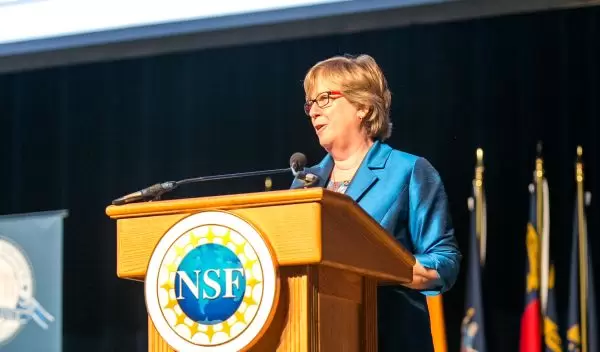
Honoring top math and science teachers
This year, the White House honored 213 recipients of the Presidential Awards for Excellence in Mathematics and Science Teaching (PAEMST). In September, those awardees traveled to Washington, D.C., where leaders in science, technology, education and mathematics (STEM) congratulated them in person.
"By virtue of receiving a PAEMST award, each of you is recognized as a model for your colleagues, an inspiration to your students and communities, and a leader in the advancement of math and science education," France Córdova, director of the National Science Foundation (NSF), told the assembled recipients.
The awards are the highest honor bestowed by the government on K-12 mathematics and science teachers. NSF receives recommendations from states and territories of some of their best and most inspiring teachers, then reviews the submissions and forwards recommendations to the White House Office of Science and Technology Policy (OSTP).
"I'm sure you all know how important your job is, how enormous a difference a good teacher makes, how you are changing lives one student at a time," OSTP Director John P. Holdren, assistant to the president for science and technology, told the group. "I think virtually every successful scientist, engineer and mathematician I know can remember a particular teacher who made a difference in his or her life. I know I do."
Awardees told NSF that they focus on creating classroom experiences that go beyond memorization of scientific facts and equations, helping students build affinities for science, technology, engineering and mathematics (STEM).
PAEMST recipients must show that they developed and implemented high-quality instructional programs that enhance student learning, demonstrating what Joan Ferrini-Mundy, head of NSF's Education and Human Resources Directorate, called "an elaborate set of accomplishments."
"Our group of awardees demonstrates excellence in these areas," she said.
This year's awardees include 108 kindergarten- to 6th-grade teachers and 105 seventh- through 12th-grade teachers. Each received $10,000 from NSF and an expense-paid trip to Washington, D.C. President Obama announced their names earlier this year, and OSTP posted a blog about their experiences during their trip. Highlights from this year's events include:
- An award banquet at the Smithsonian National Zoo, where awardees heard from keynote speaker New York Hall of Science President and CEO, Margaret Honey. Secretary of Education John B. King Jr. also commended the awardees via recorded video.
- An address by Secretary of Energy Ernest Moniz, who congratulated the awardees on their successes in the classroom and beyond, and emphasized the important role they play in ensuring a robust economy and sustainable future for today's youth. He was joined by U.S. Chief Technology Officer Megan Smith, who shared in recognizing the awardees.
- The 2016 Symposium on Active Learning in STEM Education, where awardees explored the research behind student and teacher engagement as co-learners. The symposium included a focus on innovations in mathematics learning, an area which requires special consideration to improve STEM learning outcomes at all ages. PAEMST awardees heard from national experts on active learning, as well as OSTP Associate Director for Science Jo Handelsman.
- An award ceremony at Daughters of the American Revolution Constitution Hall, where NSF's Córdova and Ferrini-Mundy and OSTP's Holdren addressed the teachers. More than 700 guests were present, including Reps. Madeleine Bordallo of Guam, Charlie Dent of Pennsylvania, Jerry McNerney of California and Paul Tonko of New York.
- The 2016 Next Generation STEM High School Forum, for which NSF and OSTP convened leaders in K-12 education to discuss and share knowledge about key components for effective STEM high schools of the 21st century. Featured speakers included OSTP Deputy Director for Policy Tom Kalil, George Washington University professor Sharon Lynch and SRI International Center for Technology in Learning Director Barbara Means.
- A gathering with PAEMST alumni leaders, including Society of Elementary Presidential Awardees President Kathy Horstmeyer, Association of Presidential Awardees in Science Teaching President Linda Smith and Council of Presidential Awardees in Mathematics President David Masunaga.
The Symposium on Active Learning in STEM Education and Next Generation STEM High School Forum were organized by NSF and the Center for Innovative Research on Cyberlearning at SRI International.
NSF has hosted the PAEMST program on behalf of OSTP since 1983. Applications for the next round of seventh through 12th grade teachers open in the fall of 2016. Nominations are accepted at the PAEMST website.


